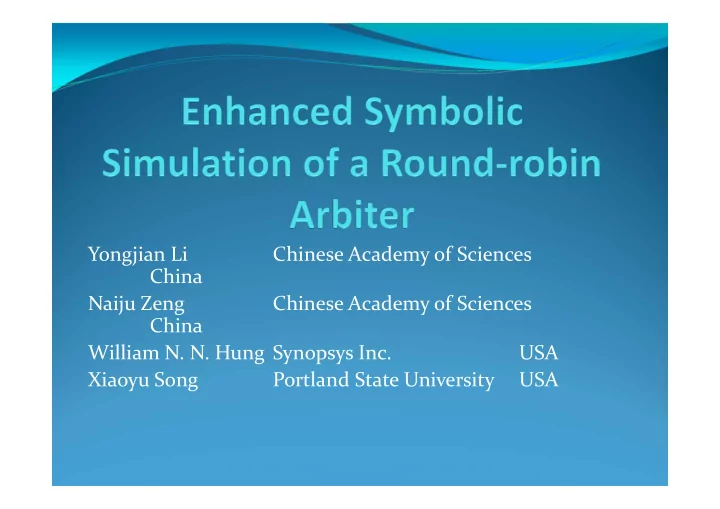

Yongjian Li Chinese Academy of Sciences China Naiju Zeng Chinese Academy of Sciences China William N. N. Hung Synopsys Inc. USA Xiaoyu Song Portland State University USA
Motivation A fast arbiter is one of the most dominant factors for high performance network switches E.g. ATM (Asynchronous Transfer Mode) network Also used in Network ‐ on ‐ Chip Hardware implementation need to be verified NxN round ‐ robin arbiter: 2 N x N cases
Related Work Curzon’s work using HOL theorem prover Pros: exhaustive, interactive Cons: not scalable (limited to 4x4 case), need fundamental modification to extend to 16x16 case Chen et al. using SMV Pros: automatic through SMV Cons: not exhaustive due to the way model was reduced Tahar et al. using MDG Pros: MDG avoids model explosion Cons: not exhaustive due to the way model was reduced
NxN switch fabric INPUT PORT OUTPUT PORT CONTROLLERS CONTROLLERS Switch SWITCH FABRIC Fabric TRANSMISSION TRANSMISSION LINES LINES Switches cells from N input controllers to N output controllers Different inputs destined for the same output? only one will succeed others are rejected, must retry later Arbitrates between these cells
Arbiter routeEnable xGrant routeEnable xGrant ARBITER_XY Arbiter_XY ItReq 0-3 yGrant ItReq 0 … 3 yGrant There are N arbiters: one for each output port Each arbiter arbitrates the requests from N input ports ItReq: 1 ‐ bit per input port Output: vector encoding of arbitration result
Round ‐ robin Arbitration Request with highest priority in round ‐ robin order is granted in each cycle Fairness (no starvation) Worst ‐ case wait time: #requestors ‐ 1
Symbolic Trajectory Evaluation Formal verification technique based on ternary symbolic simulation Specification: ant ~> cons ant , cons are trajectory formula Verification: cktSat C ant ~> cons Circuit Model V = df {ff, tt, X, T} dual ‐ rail encoding A circuit state is an instantaneous snapshot of a circuit behavior given by an assignment of V to nodes of the circuit
Generalized Symbolic Trajectory Evaluation STE can only deal with bounded time Generalized Symbolic Trajectory Evaluation (GSTE) extension of STE deal with properties ranging over unbounded time Properties are specified by assertion graphs, which are ‐ automaton
Example: Memory Cell write = AndList [Is1 wr , din isB bD , a isB bA ] retain = AndList [ wr isB bWr , a isB ( bWr bA )] read = AndList [Is0 wr , a isB bA ] outResult = dout isB bD
STE for Memory Cell ant = AndList [ write , Next retain , Next 2 read ] cons = Next 2 outResult ant ~> cons
Verify one round of arbitration Given: last value selected Return: the next highest value requested with suitable wrap around from the highest possible request to the lowest
One Round of Arbitration
STE Specification
Sequential Behavior of Arbiter
GSTE specification
Parameterized Verification NxN Round ‐ robin Arbiter
Experimental Results
Response property specifies that once a request req i is set high from a state and kept high, then the request will be granted after several cycles. The worst case waiting time for the request to be granted can also be predicted. . Example : Consider a state where the value of grant is [ ff, tt], which means that the last request granted is req2, if the request req2 is set high again and kept high, then the request will be granted (or the value of grant is set [ff,tt] again) after at most 4 cycles. Namely, the worst ‐ case waiting time for this request to be granted is 4.
Constraint ‐ based 1. Randomly walking around the edges of GSTE 2. graph
req0 x req1 req2 req3 x reset routeEnable clock grant1 grant0
reset x clock x req1 x x req2 x x req3 x x x x routeEnable x x req0 x x grant1 x grant0 x
HOL specification let SUC_MODN N last = (last + 1 = len) => 0 | (last + 1); letrec RoundRobin 0 requestSet last N = 0 /\ RoundRobin n requestSet last N = let tryNext = SUC_MOD N last in ((tryNext mem requestSet) => tryNext | RoundRobin (n – 1) requestSet tryNext); let RoundRobinArbiter N requestSet last = (requestSet = []) => NORESULT | (RESULT (RoundRobin N requestSet last));
HOL Specification (part 2) let RequestsToArbitrate 0 reqVect = [] /\ RequestsToArbitrate n reqVect = (requests ! (n ‐ 1)) => ([n] union (RequestsToArbitrate (n ‐ 1) requests) |RequestsToArbitrate (n ‐ 1) requests; let SuccessFullInput last reqVect = let requestSet = RequestsToArbitrate (length reqVect) reqVect in (RoundRobinArbiter (length reqVect) requestSet last); let GrantForOut reqVect grantVect = let sucInp = SuccessFullInput (BNVAL grantVect) reqVect in (suc_inp = NORESULT) => grantVect | (val (RESULT result = sucInp) in VAL2VEC (length grantVect) result));
Recommend
More recommend